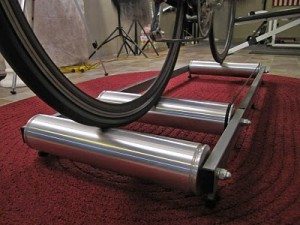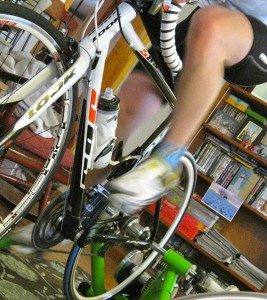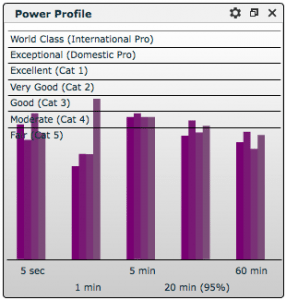When a coach or friend mentions indoor training, time on the rollers, or trainer time, most riders either cringe or comment that they only ride the trainer when they “have no other choice.” But in reality, indoor training has many benefits, not the least of which is being able to fit training into your busy schedule very easily. You also have ultimate control over your workout: there's no worrying about wind, terrain, road surface, animals or traffic. This means you'll be able to do your intervals down to the second, stop immediately if you tire, control temperature and airflow and set your interval resistance precisely. What more could you ask for? Well, for starters, let's look at some of the basics of indoor training, some tips to make your sessions more productive and a couple of my favorite workouts.
Rollers or Trainer?
This topic is really one that is broad enough to constitute a post in itself. However, in the interest of giving a “Reader's Digest” version, I'll say this:
Both.
Really? Both?
Yes, both, and I'll tell you why. It's about working on different skills. The trainer will be your go-to tool for working on intervals and intensity. It provides more resistance for you to work against (adjustable in some cases) and it provides a stable platform for out of the saddle efforts, sprint efforts and extremely high intensity efforts since you don't have to worry about falling off. On the other hand, because you're bolted to the trainer, your pedal stroke will suffer. On rollers, you're forced to pay attention to your form. Keeping your upper body relaxed and fluid and your attention on your form will force you to examine your technique in search of flaws (and you'll notice them quickly.) Pedal stroke work (single leg if you dare) and cadence based intervals are best done on the rollers to allow you to smooth out your pedal stroke and increase your gross efficiency.
Those considerations aside, what else do you need to know about indoor training? Let's explore some of the pitfalls of doing your work indoors and after that, I'll give you a couple of my favorite indoor workouts.
 Indoor Training Essentials
Indoor Training Essentials
Indoor riding may sound easy, but it is fraught with issues. You'll soon discover that there is no cool breeze in your face, hills to add intensity or pretty roadside sights to keep your mind off the pain in your legs. With that in mind, you can do a few things to minimize the extra pain of training indoors.
Keeping yourself entertained will help you pass the time and focus on something more than just your Garmin or the pain in your legs. And since indoor training can be remarkably dull and lockstep, some form of entertainment will keep your training sessions from becoming less training and more mental torture. Using an iPod or similar MP3 player with earbuds or headphones will not only drown out the sound of the trainer but give you a distraction from the tedium. As a bonus, you can select music that facilitates your workout for the day: heavy metal tracks for climbing intervals, driving techno beats for high cadence work and groovy funk for long steady state work.
 Staying hydrated and cool are two more important considerations when training indoors. Since we don't have any forward momentum and we are literally just spinning our wheels, there's no airflow over our body to cool us and keep our core temperature down. The increased heat (a result of poor evaporative cooling) will cause increased sweat production and fluid loss. It's not surprising that both of these can do a lot to curb your performance, and these are often the reason why indoor FTP tests can be as much as 10% less than what can be done on the open road. It's also worth noting that interval work and other training will typically feel harder indoors: getting to that 100% FTP number will probably feel like you're trying to climb the Galibier with two people on your back. So how do you combat this? First off, stay well hydrated, drinking plenty of water and/or electrolyte mix before, during and after your indoor sessions. Second, consider the use of several good quality fans to keep the air moving over your body. Alternatively, you can use one BAF ([easyazon_link identifier=”B01FFT0BAY” locale=”US” tag=”taicoaandthed-20″]Big Ass Fan[/easyazon_link]) to blow in your face like a stiff headwind. This doubles as a psychological aid to help you tolerate riding into headwinds better.
Staying hydrated and cool are two more important considerations when training indoors. Since we don't have any forward momentum and we are literally just spinning our wheels, there's no airflow over our body to cool us and keep our core temperature down. The increased heat (a result of poor evaporative cooling) will cause increased sweat production and fluid loss. It's not surprising that both of these can do a lot to curb your performance, and these are often the reason why indoor FTP tests can be as much as 10% less than what can be done on the open road. It's also worth noting that interval work and other training will typically feel harder indoors: getting to that 100% FTP number will probably feel like you're trying to climb the Galibier with two people on your back. So how do you combat this? First off, stay well hydrated, drinking plenty of water and/or electrolyte mix before, during and after your indoor sessions. Second, consider the use of several good quality fans to keep the air moving over your body. Alternatively, you can use one BAF ([easyazon_link identifier=”B01FFT0BAY” locale=”US” tag=”taicoaandthed-20″]Big Ass Fan[/easyazon_link]) to blow in your face like a stiff headwind. This doubles as a psychological aid to help you tolerate riding into headwinds better.
So, now that you're staying cool, hydrated and motivated, what should you do with those endless hours on the trainer/rollers?
Indoor Interval Sessions
It should go without saying that “just riding” for an hour on the trainer will do you pretty much no good. You won't get much out of it except a few burned calories, and certainly nothing of physiological benefit other than “saddle time.” The only time where “just riding” is acceptable is if you're trying to get base time in, which is simply zone 2 and low zone 3 riding at a comfortable cadence. Keep in mind that if you're doing a proper “not-so off season” you shouldn't have to do a lot of this work anyway, but that's a completely different topic which I'll cover at another time.
If you're not “just pedaling away” then what should you be doing?
Let's start with some technique work, shall we? What could be better than increasing your power numbers even though you're not suffering hard in zone 5? By increasing the efficiency of your pedaling form, you'll use less energy for a given pedal stroke and your upper body will be less involved, leaving more oxygen for your legs to utilize. Doing this kind of work on the rollers gives you loads of feedback on your form and you'll very easily be able to tell when you're getting smoother; it'll be easier to stay on the rollers and your body will be much more fluid. Try the following workout twice per week in your base period and keep it up once per week in your build phase:
Speed Pyramids
Duration: ~ 1 hour
Best done on: Rollers
- Warm up with 15 minutes of spinning under light tension
- Ride 4 minutes at 80 RPM
- Ride 3 minutes at 90 RPM
- Ride 2 minutes at 100 RPM
- Ride 1 minute at 110 RPM
- Ride 2 minutes at 100 RPM
- Ride 3 minutes at 90 RPM
- Ride 4 minutes at 80 RPM
- Repeat the whole pyramid a second time, but do each step 10 RPM higher than the first pyramid
- Cool down for 10 minutes
For advanced riders, (or if you're just feeling badass,) do another pyramid and increase the RPMs by 10 again.
An alternative pyramid workout that puts your threshold power in the spotlight involves doing FTP pyramids instead of cadence based pyramids. In the case of these FTP pyramids, cadence should be within your comfort zone and you will be working off your FTP/LTHR numbers for intensity. You can use this workout one to two times per week during your base and build periods, in lieu of “traditional FTP intervals.”
FTP Pyramids
Duration: ~ 1 hour
Best done on: Trainer
- Warm up with 10 minutes of spinning under light tension, after 10 minutes, do a 1 minute threshold level/110% FTP/LTHR effort in the middle of the warmup.
- Ride 4 minutes at Sweet Spot (about 91% FTP/93-4% LTHR) to get your body cooking
- Ride 3 minutes at 100% FTP/LTHR
- Ride 2 minutes at 115% FTP/HARD (9/10 RPE)
- Ride 1 minute at 130% FTP/VERY HARD (10/10 RPE)
- Ride 2 minutes at 115% FTP/HARD (9/10 RPE)
- Ride 3 minutes at 100% FTP/LTHR
- Ride 4 minutes at sweet spot (about 91% FTP/93-4% LTHR)
- Ride 3 minutes at 100% FTP/LTHR
- Ride 2 minutes at 120% FTP/HARD (9/10 RPE)
- Ride 1 minute at 150% FTP/VERY HARD (10/10 RPE)
- Ride 2 minutes at 120% FTP/HARD (9/10 RPE)
- Ride 3 minutes at 100% FTP/LTHR
- Cool down for 10 minutes (or if you're feeling badass, do another pyramid.)
For advanced riders, or as you progress with these pyramids, try increasing the peak power output for the first and second pyramids, and adjust the ramps accordingly.
Now that we've spent some time working on smoothing out our form and reducing wasted energy, and we've spent some time building our threshold and increasing our tolerance for supra-threshold efforts, we can combine the two into one of the most important skills necessary for group riding and racing: zone 5 repeatability.
Zone 5 repeats
Duration: ~50 minutes
Best done on: Either trainer or rollers, depending on technique
- Warm up with 10 minutes of spinning under light tension, after 10 minutes, do a 1 minute threshold level/110% FTP/LTHR effort in the middle of the warmup.
- Ride for 1 minute at 100% FTP/LTHR/Zone 4
- Ride for 30 seconds at 115% FTP/Zone 5(>105% LTHR, RPE 9, HARD)
- Repeat 10 times
- Rest for 3 minutes
- Ride for 1 minute at 100% FTP/LTHR/Zone 4
- Ride for 30 seconds at 115% FTP/Zone 5 (>105% LTHR, RPE 9, HARD)
- Repeat 10 times
- Cool down for 5 minutes
For advanced riders, consider shortening the time at FTP/LTHR and lengthening the time at Zone 5 (do 45 seconds/45 seconds for example) to increase the training stimulus and add variation. You can also vary the method you use to increase your power output: on rollers you can make your Zone 5 reach based on cadence (speeding up your cadence by 10 RPM to add 15% more power output), on the trainer you can stand on the pedals to increase your power output, and on both you can simply shift to a harder gear at the same cadence to increase your power output. Each method has its own relevance to your everyday riding and racing.
Maintaining Motivation
It can be extremely difficult to stay motivated to train indoors for long periods of time. For those cyclists who don't venture out into the sub-freezing temperatures or when the roads are snow, salt and ice covered, the trainer or rollers may be your only training method. The problem with them, however, is the monotony of riding inside, in one place, for a long period of time. You go nowhere, and you can only watch those re-runs of the Giro and Tour so many times before you zone out and get sick of them. So how do you keep your motivation high?
Train With A Group
 Many bike shops have a dedicated “trainer night” during which people bring their bikes, their trainers and their willingness to suffer to the shop, set up and go for a “group ride” without going anywhere. Often these sessions are directed by a training video or DVD (oh, how many times did I ride with that awful Coach Troy….) and are designed to work on specific segments of your fitness. There's also a significant amount of motivation in an arrangement like this, because nobody wants to quit or show weakness in front of their friends, teammates or rivals.
Many bike shops have a dedicated “trainer night” during which people bring their bikes, their trainers and their willingness to suffer to the shop, set up and go for a “group ride” without going anywhere. Often these sessions are directed by a training video or DVD (oh, how many times did I ride with that awful Coach Troy….) and are designed to work on specific segments of your fitness. There's also a significant amount of motivation in an arrangement like this, because nobody wants to quit or show weakness in front of their friends, teammates or rivals.
This arrangement can also apply to spin classes (if you're into that sort of thing), computrainer classes (there are some “studios” out there that offer these, believe it or not) and other kinds of group activities. Of course, training outdoors with a group is often the only thing to get someone out the door during the winter, but that's another post entirely.
If you don't have a group nearby, or you don't want to deal with having to modify your workouts to fit around the group's goals, consider some other methods of keeping your motivation high, such as…
Hire A Coach, Use A Training Plan
Yes, this is the obligatory plug for what I do, but there is a lot of merit in it and a great number of people see their biggest gains while following a structured plan that holds them accountable. A good coach does more than just provide you with a training plan; they are your guide through that training plan, they hold you accountable for your workouts on a daily, weekly and monthly basis. Should you find that you're losing your motivation, only a second thought of disappointing your coach, or wasting all the time you put into your training plan will be the impetus you need to get back on the trainer.
As for motivating yourself with a training plan, nothing beats being able to see your progress in real, honest numerical form (at least if you're into motivating yourself that way.) In that case, things like Strava can be beneficial. Even greater than Strava is a tool like Zwift or TrainerRoad. This online program not only has it's own workouts built in, but it can display power numbers by calculating speed, cadence and the resistance curve of your trainer. Not quite useful on rollers, but it is an excellent training tool to keep you motivated.
Don't want the structure of a training plan or the idea of a coach breathing down your neck? Try using training videos like the [easyazon_link identifier=”B004BNMCNK” locale=”US” tag=”taicoaandthed-20″]Real Rides[/easyazon_link] series (where you ride alongside Robbie Ventura as he climbs, sprints and races) or the Sufferfest series (which includes professional cycling footage for you to ogle.) These videos are just like having a group around you, but without the other riders breathing in your ear or sweating on your floor.
